sensor HONDA CR-V 2011 RD1-RD5, RE7 / 3.G Owners Manual
[x] Cancel search | Manufacturer: HONDA, Model Year: 2011, Model line: CR-V, Model: HONDA CR-V 2011 RD1-RD5, RE7 / 3.GPages: 445, PDF Size: 8.06 MB
Page 13 of 445
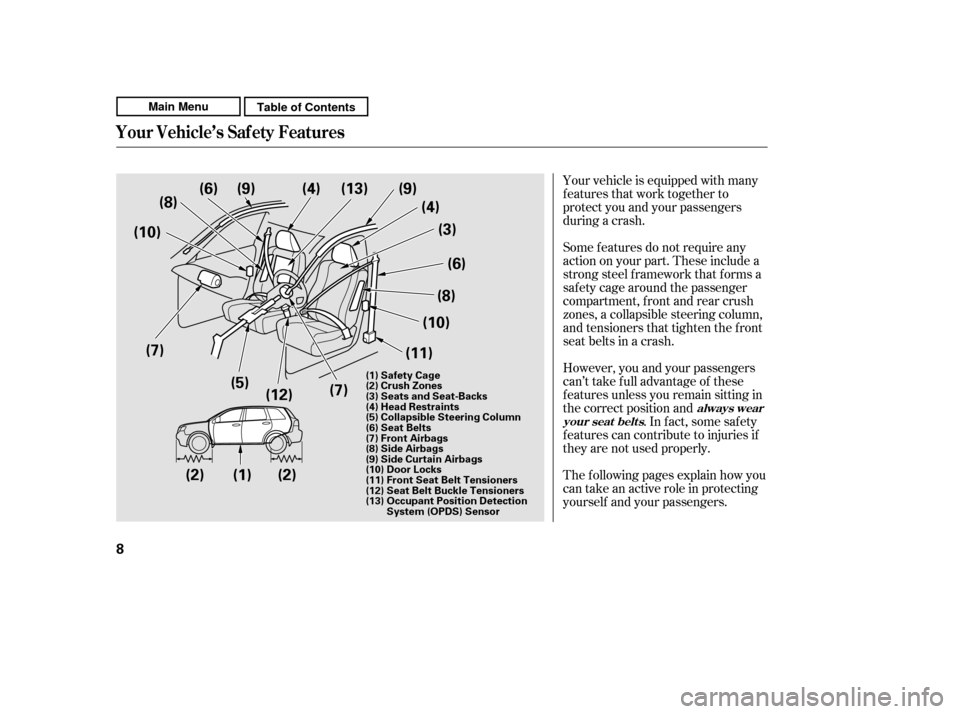
Your vehicle is equipped with many
features that work together to
protect you and your passengers
during a crash.
However, you and your passengers
can’t take f ull advantage of these
f eatures unless you remain sitting in
the correct position and. In fact, some safety
f eatures can contribute to injuries if
they are not used properly.
The f ollowing pages explain how you
cantakeanactiveroleinprotecting
yourself and your passengers.
Some f eatures do not require any
action on your part. These include a
strong steel f ramework that f orms a
saf ety cage around the passenger
compartment, front and rear crush
zones, a collapsible steering column,
and tensioners that tighten the f ront
seat belts in a crash.
always wear
your seat belts
Your Vehicle’s Saf ety Features
8
(7)
(10)
(2) (11)
(12)
(8)
(2)(7)
(4)
(5) (13) (9)
(1) (10)
(9)
(6)
(4)
(3)
(6)
(8)
(1) Safety Cage
(2) Crush Zones
(3) Seats and Seat-Backs
(4) Head Restraints
(5) Collapsible Steering Column
(6) Seat Belts
(7) Front Airbags
(8) Side Airbags
(9) Side Curtain Airbags
(10) Door Locks
(11) Front Seat Belt Tensioners
(12) Seat Belt Buckle Tensioners
(13) Occupant Position Detection System (OPDS) Sensor
Main MenuTable of Contents
Page 28 of 445
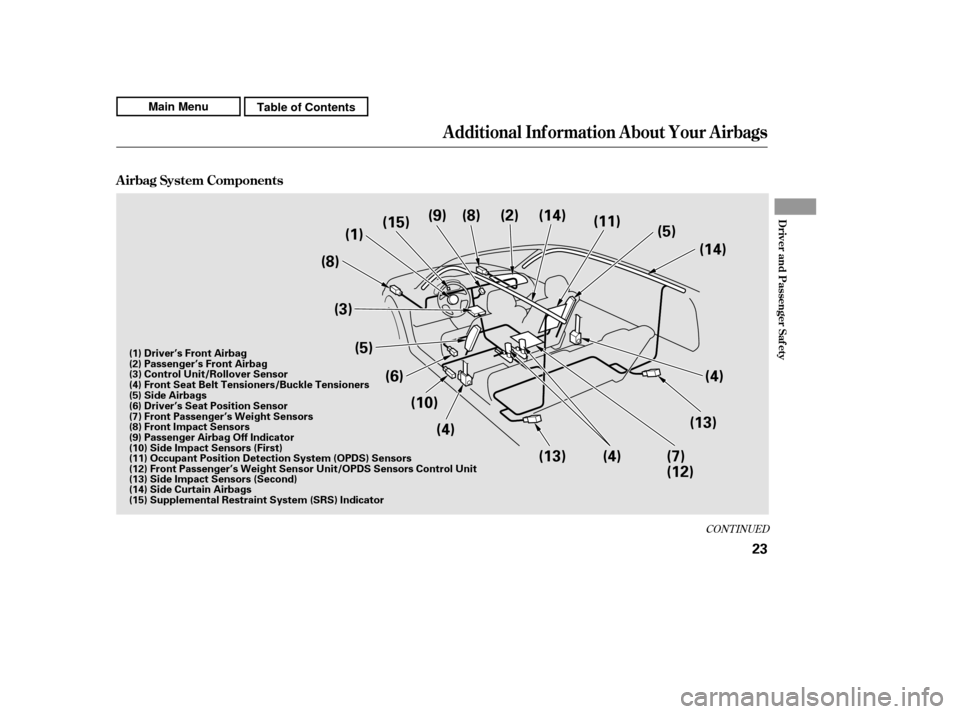
CONT INUED
A irbag System Components
Additional Inf ormation About Your Airbags
Driver and Passenger Saf ety
23
(1)(2)
(3)
(4)
(6)
(5)
(4)
(8)
(8) (14)
(10) (13)
(4)
(7)
(12)
(15)
(9)
(11)
(5)
(14)
(13)
(1) Driver’s Front Airbag
(2) Passenger’s Front Airbag
(3) Control Unit/Rollover Sensor
(4) Front Seat Belt Tensioners/Buckle Tensioners
(5) Side Airbags
(6) Driver’s Seat Position Sensor
(7) Front Passenger’s Weight Sensors
(8) Front Impact Sensors
(9) Passenger Airbag Off Indicator
(10) Side Impact Sensors (First)
(11) Occupant Position Detection System (OPDS) Sensors
(12) Front Passenger’s Weight Sensor Unit/OPDS Sensors Control Unit
(13) Side Impact Sensors (Second)
(14) Side Curtain Airbags
(15) Supplemental Restraint System (
SRS) Indicator
Main MenuTable of Contents
Page 29 of 445

Your airbag system includes:Two SRS (supplemental restraint
system) f ront airbags. The driver’s
airbag is stored in the center of
the steering wheel; the f ront
passenger’sairbagisstoredinthe
dashboard. Both are marked ‘‘SRS
AIRBAG’’ (see page ).
Two side airbags, one f or the
driver and one f or a f ront
passenger. The airbags are stored
in the outer edges of the seat-
backs. Both are marked ‘‘SIDE
AIRBAG’’ (see page ).
Two side curtain airbags, one f or
each side of the vehicle. The
airbags are stored in the ceiling,
above the side windows. The f ront
and rear pillars are marked ‘‘SIDE
CURTAIN AIRBAG’’ (see page ). Automatic front seat belt
tensioners (see page ).
Sensors that can detect a
moderate to severe front impact,
side impact, or if your vehicle is
about to rollover.
Sensors that can detect whether a
child is in the passenger’s side
airbag path and signal the control
unit to turn the airbag of f (see
page ).
A driver’s seat position sensor that
monitors the distance of the seat
from the front airbag. If the seat is
too f ar f orward, the airbag will
inf late with less f orce (see page
). Weight sensors that monitor the
weight on the f ront passenger’s
seat. If the weight is about 65 lbs
(29 kg) or less (the weight of an
inf ant or small child), the
passenger’s f ront airbag will be
turned of f (see page ).
Sensors that can detect whether
the driver’s seat belt and the f ront
passenger’s seat belt are latched
or unlatched (see page ).
A sophisticated electronic system
that continually monitors and
records inf ormation about the
sensors, the control unit, the
airbag activators, the seat belt
tensioners, and driver and f ront
passenger seat belt use when the
ignition switch is in the ON (II)
position.
31 29
25 21
30
28 28
19
Additional Inf ormation About Your Airbags
24
Main MenuTable of Contents
Page 30 of 445
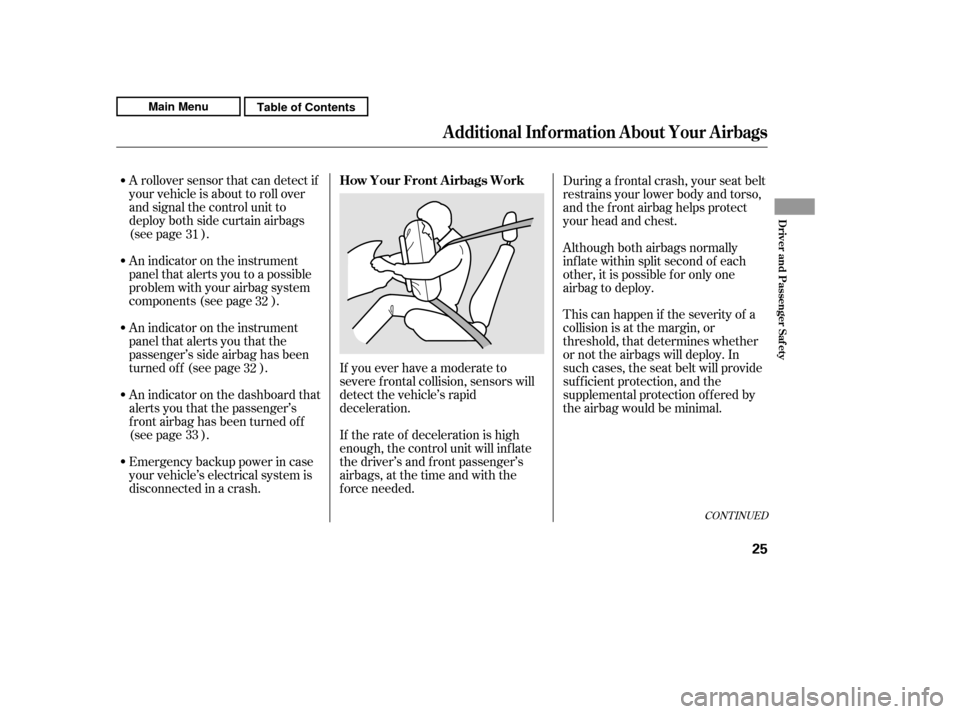
A rollover sensor that can detect if
your vehicle is about to roll over
and signal the control unit to
deploy both side curtain airbags
(see page ).
An indicator on the instrument
panel that alerts you to a possible
problem with your airbag system
components (see page ).
An indicator on the instrument
panel that alerts you that the
passenger’s side airbag has been
turned of f (see page ).
An indicator on the dashboard that
alerts you that the passenger’s
f ront airbag has been turned of f
(see page ).
Emergency backup power in case
your vehicle’s electrical system is
disconnected in a crash.During a frontal crash, your seat belt
restrains your lower body and torso,
and the f ront airbag helps protect
your head and chest.
Although both airbags normally
inf late within split second of each
other, it is possible f or only one
airbag to deploy.
This can happen if the severity of a
collision is at the margin, or
threshold, that determines whether
or not the airbags will deploy. In
such cases, the seat belt will provide
suf f icient protection, and the
supplemental protection of f ered by
the airbag would be minimal.
If you ever have a moderate to
severe f rontal collision, sensors will
detect the vehicle’s rapid
deceleration.
If the rate of deceleration is high
enough, the control unit will inf late
the driver’s and f ront passenger’s
airbags, at the time and with the
f orce needed.
33 3232
31
CONT INUED
Additional Inf ormation About Your Airbags
How Your Front A irbags Work
Driver and Passenger Saf ety
25
Main MenuTable of Contents
Page 32 of 445

CONT INUED
Failure to f ollow these instructions
could damage the sensors or prevent
them f rom working properly.
Your f ront airbags are also advanced
airbags. The main purpose of this
feature is to help prevent airbag-
caused injuries to short drivers and
children or small-statured adults who
ride in f ront.
For both advanced airbags to work
properly:
Do not spill any liquids on or
under the seats, cover the sensors,
or put any objects or metal items
under the f ront seats.
Occupants must sit upright and
wear their seat belts properly.
Objects placed or pushed under
the f ront passenger’s seat may
cause the sensor to malf unction,
increasing the risk of injury in a
crash.
Your vehicle is equipped with dual-
stage, multiple-threshold f ront
airbags (SRS). During a f rontal crash
severe enough to cause one or both
f ront airbags to deploy, the airbags
can inf late at dif f erent rates,
depending on the severity of the
crash, whether or not the seat belts
are latched, and/or other f actors.
Front airbags are designed to
supplement the seat belts to help
reduce the likelihood of head and
chest injuries in f rontal crashes.
Additional Inf ormation About Your Airbags
Advanced Airbags
Dual-St age, Mult iple-T hreshold
Front A irbags (SRS)
Driver and Passenger Saf ety
27
Main MenuTable of Contents
Page 33 of 445
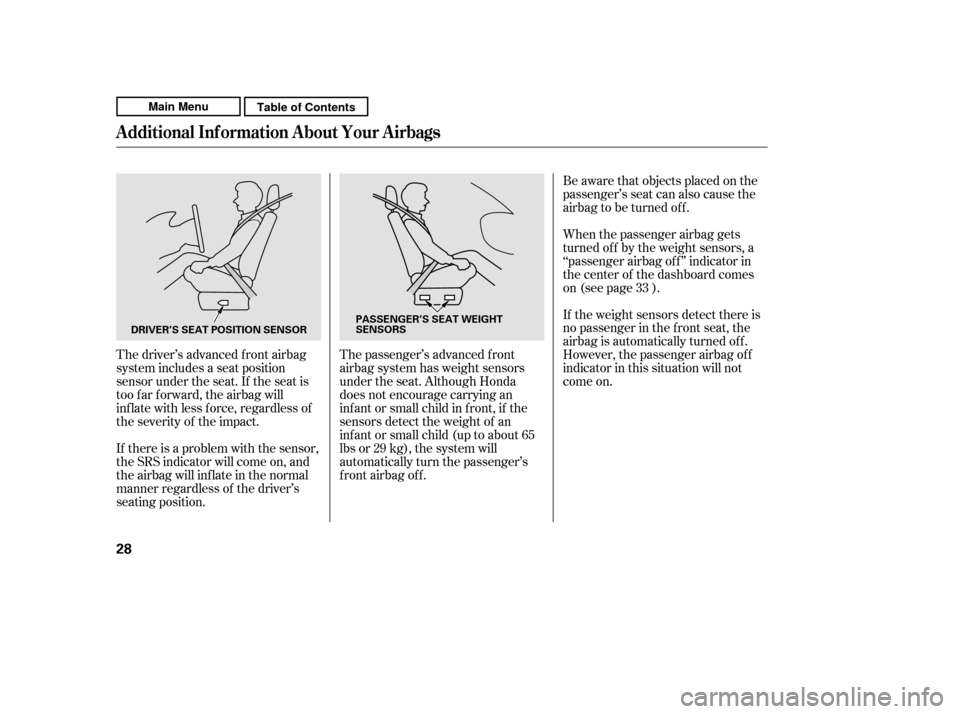
The driver’s advanced front airbag
system includes a seat position
sensor under the seat. If the seat is
too f ar f orward, the airbag will
inf late with less f orce, regardless of
the severity of the impact.
If there is a problem with the sensor,
the SRS indicator will come on, and
the airbag will inf late in the normal
manner regardless of the driver’s
seating position.The passenger’s advanced f ront
airbag system has weight sensors
under the seat. Although Honda
does not encourage carrying an
inf ant or small child in f ront, if the
sensors detect the weight of an
inf ant or small child (up to about 65
lbs or 29 kg), the system will
automatically turn the passenger’s
front airbag off.Be aware that objects placed on the
passenger’s seat can also cause the
airbag to be turned of f .
When the passenger airbag gets
turned of f by the weight sensors, a
‘‘passenger airbag of f ’’ indicator in
the center of the dashboard comes
on (see page ).
If the weight sensors detect there is
no passenger in the f ront seat, the
airbag is automatically turned off.
However, the passenger airbag of f
indicator in this situation will not
come on.
33
Additional Inf ormation About Your Airbags
28
DRIVER’S SEAT POSITION SENSOR
PASSENGER’S SEAT WEIGHT
SENSORS
Main MenuTable of Contents
Page 34 of 445
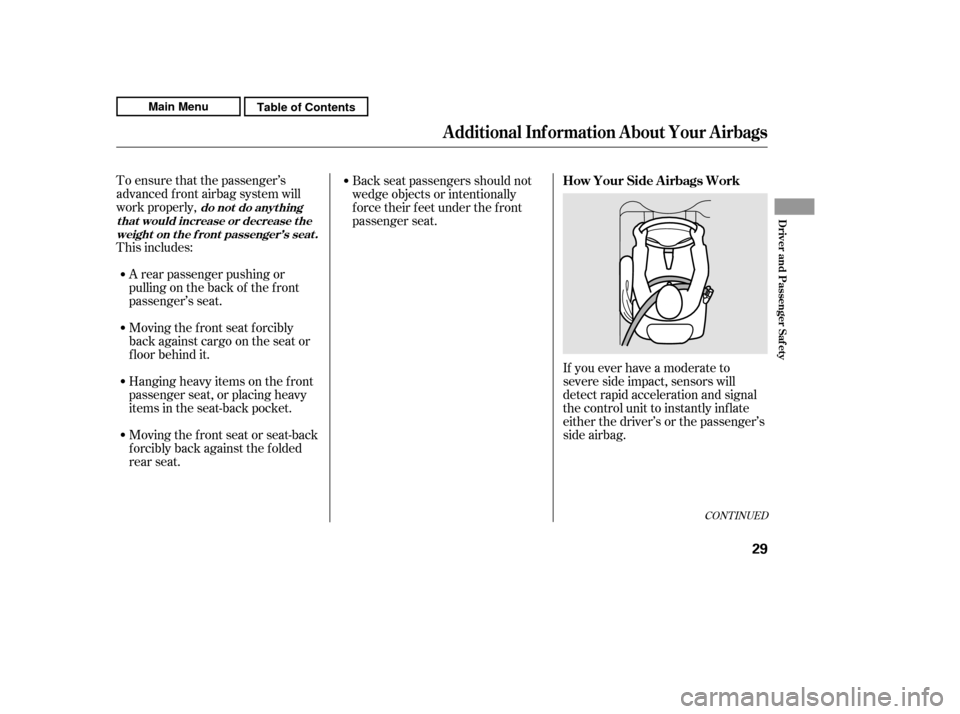
CONT INUED
To ensure that the passenger’s
advanced front airbag system will
work properly,
This includes:A rear passenger pushing or
pulling on the back of the f ront
passenger’s seat.
Moving the f ront seat f orcibly
back against cargo on the seat or
f loor behind it.
Hanging heavy items on the f ront
passenger seat, or placing heavy
items in the seat-back pocket.
Moving the front seat or seat-back
f orcibly back against the f olded
rear seat. Back seat passengers should not
wedge objects or intentionally
f orce their f eet under the f ront
passenger seat.
If you ever have a moderate to
severe side impact, sensors will
detect rapid acceleration and signal
the control unit to instantly inf late
either the driver’s or the passenger’s
side airbag.
How Your Side A irbags Work
Additional Inf ormation About Your Airbags
do not do anyt hing
t hat would increase or decrease t he
weight on the f ront passenger’s seat.Driver and Passenger Saf ety
29
Main MenuTable of Contents
Page 35 of 445

There will be some delay between
the moment the passenger moves
into or out of the airbag deployment
pathandwhentheindicatorcomes
on or goes of f .
A f ront seat passenger should not
use a cushion or another object as a
backrest. It may prevent the cutof f
system f rom working properly.
Only one airbag will deploy during a
side impact. If the impact is on the
passenger’s side, the passenger’s
side airbag will deploy even if there
is no passenger.
To get the best protection f rom the
side airbags, front seat occupants
should wear their seat belts and sit
upright and well back in their seats.
If the side airbag of f indicator comes
on (see page ), have the
passenger sit upright. Once the
passenger is out of the airbag’s
deployment path, the system will
turn the airbag back on, and the
indicator will go out.
Your vehicle has a side airbag cutof f
system designed primarily to protect
a child riding in the f ront passenger’s
seat.
Although Honda does not encourage
children to ride in f ront, if the
position sensors detect a child has
leaned into the side airbag’s
deployment path, the airbag will shut
off.
Thesideairbagmayalsoshutoff if a
short adult leans sideways, or a
larger adult slouches and leans
sideways into the airbag’s
deployment path.
Objects placed on the f ront
passenger seat can also cause the
side airbag to be shut of f . 32
Side A irbag Cut of f Syst em
Additional Inf ormation About Your Airbags
30
Main MenuTable of Contents
Page 36 of 445
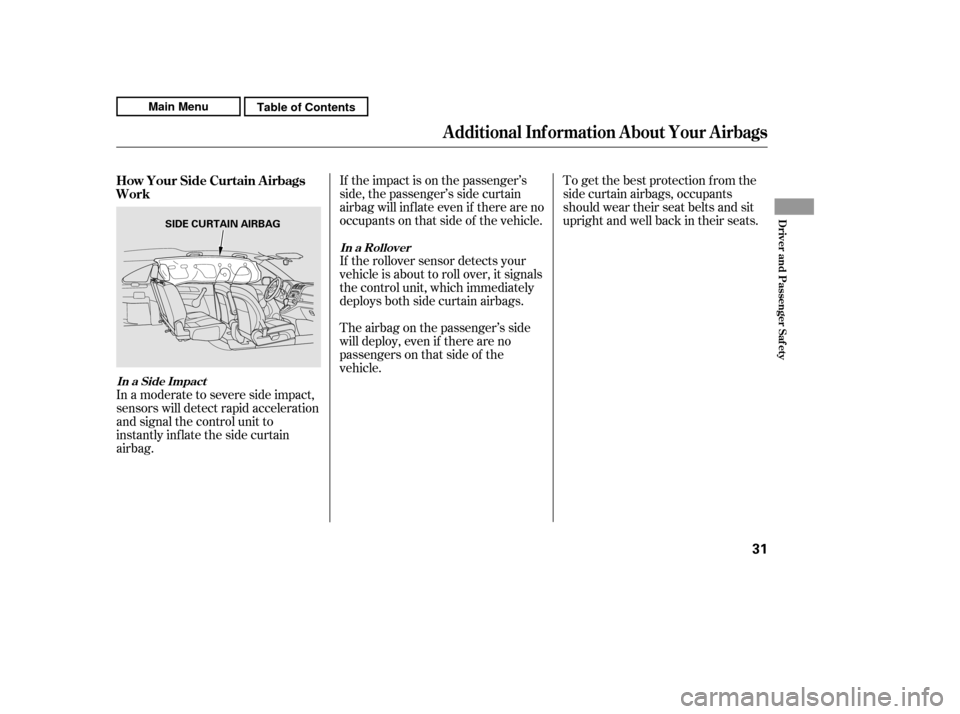
If the impact is on the passenger’s
side, the passenger’s side curtain
airbag will inf late even if there are no
occupants on that side of the vehicle.To get the best protection f rom the
side curtain airbags, occupants
should wear their seat belts and sit
upright and well back in their seats.
In a moderate to severe side impact,
sensors will detect rapid acceleration
and signal the control unit to
instantly inflate the side curtain
airbag. If the rollover sensor detects your
vehicle is about to roll over, it signals
the control unit, which immediately
deploys both side curtain airbags.
The airbag on the passenger’s side
will deploy, even if there are no
passengers on that side of the
vehicle.
How Your Side Curtain A irbags
Work
In a Side Impact
In a Rollover
Additional Inf ormation About Your Airbags
Driver and Passenger Saf ety
31
SIDE CURTAIN AIRBAG
Main MenuTable of Contents
Page 38 of 445
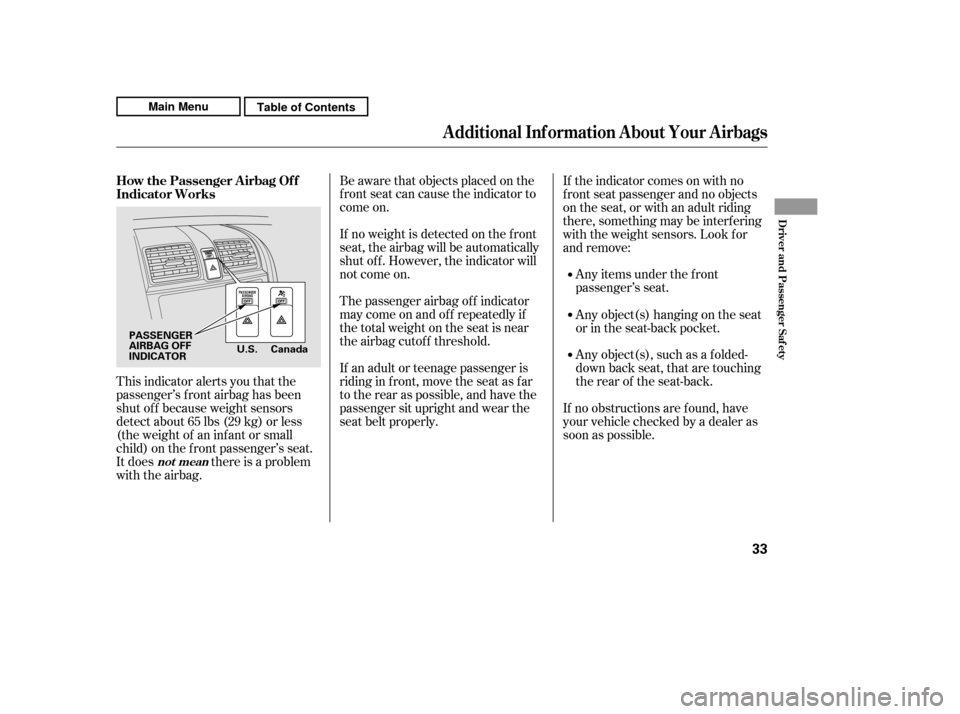
This indicator alerts you that the
passenger’s f ront airbag has been
shut of f because weight sensors
detect about 65 lbs (29 kg) or less
(the weight of an inf ant or small
child) on the f ront passenger’s seat.
It does there is a problem
with the airbag.Be aware that objects placed on the
f ront seat can cause the indicator to
come on.
If no weight is detected on the f ront
seat, the airbag will be automatically
shut of f . However, the indicator will
not come on.
The passenger airbag of f indicator
maycomeonandoff repeatedlyif
the total weight on the seat is near
the airbag cutof f threshold.
If the indicator comes on with no
f ront seat passenger and no objects
on the seat, or with an adult riding
there, something may be interf ering
with the weight sensors. Look f or
and remove:
Any items under the f ront
passenger’s seat.
Any object(s), such as a f olded-
down back seat, that are touching
the rear of the seat-back.
If no obstructions are f ound, have
your vehicle checked by a dealer as
soon as possible.
If an adult or teenage passenger is
riding in f ront, move the seat as f ar
to the rear as possible, and have the
passenger sit upright and wear the
seat belt properly. Any object(s) hanging on the seat
or in the seat-back pocket.
How the Passenger Airbag Of f
Indicator Works
not mean
Additional Inf ormation About Your Airbags
Driver and Passenger Saf ety
33
Canada
U.S.
PASSENGER
AIRBAG OFF
INDICATOR
Main MenuTable of Contents